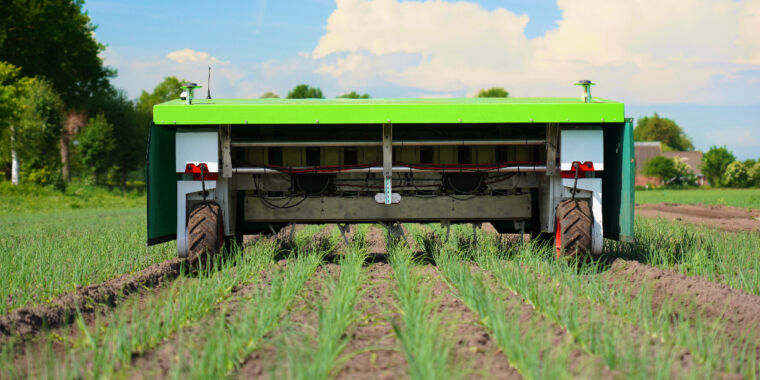Anyone who has engaged in the task of weeding a garden is well aware of its tedious nature. When this chore is scaled up to farm-sized proportions, it transforms into a daunting nightmare. The conventional solution of using herbicides on a large scale poses significant risks to humans, animals, and the environment. In response to this challenge, a Swedish company called Ekobot AB has introduced a groundbreaking wheeled robot equipped with the capability to autonomously identify and remove weeds from the soil using its metal fingers.
The Ekobot WEAI robot, sporting four wheels, operates on a battery that sustains it for 10–12 hours on a single charge. Weighing 600 kg (approximately 1322 pounds), this innovative robot can reach a top speed of 5 km/h (equivalent to 2.5 mph). Specifically designed for weeding fields abundant with onions, beetroots, carrots, and similar vegetables, it can cover an impressive area of about 10 hectares (roughly 24.7 acres) within a day’s work. By leveraging GPS RTK for navigation and incorporating safety sensors and vision systems, the robot adeptly avoids collisions with objects or individuals during its operation.
Utilizing an AI-powered machine vision system, the Ekobot effectively identifies weeds as it traverses the farm field. Once the targeted weeds are detected, the robot swiftly uproots them using its array of metal fingers. Ekobot proudly asserts that through trials, farmers were able to cultivate onions with a remarkable 70 percent reduction in pesticide usage, thanks to the efficiency of the weed-plucking robot. The precision of the weed recognition system is pivotal in ensuring that the robot does not mistakenly disturb the crops during its weeding process.
Two years back, Ekobot forged a partnership with the Swedish telecom giant Telia, resulting in the integration of 5G mobile technology into the robot. This enhancement enables the robot to communicate wirelessly with a central server, facilitating the sharing of acquired data from any location within the farm field. Initially implemented in a pilot project focused on onion cultivation, this technological advancement has now yielded the first batch of “5G onions” produced through this innovative weeding approach.
According to a statement from Telia, “The 5G onion has demonstrated an extended shelf life, leading to a reduction in wastage. Furthermore, the 5G onion not only promotes sustainability but also offers enhanced taste. This is attributed to the efficient weeding process and reduced pesticide application, allowing the onion shoots to flourish more vigorously and for a longer duration. Consequently, the onions receive ample sunlight and nutrients, resulting in a robust and flavorful produce.”
Telia has announced the limited availability of 5G onions in select Telia stores and hinted at the imminent application of Ekobot’s weeding technology on carrots and beets. Apart from Sweden, this cutting-edge technology is also accessible in the Netherlands and is set to expand to Denmark and Norway. Telia anticipates that the Ekobot system will be accessible in “9 EU countries, the United Kingdom, and the United States” by the year 2030. When combined with ongoing research on laser technology designed to eliminate pests in flight, AI stands poised to revolutionize farming practices towards a more sustainable and eco-friendly future upon widespread adoption.






